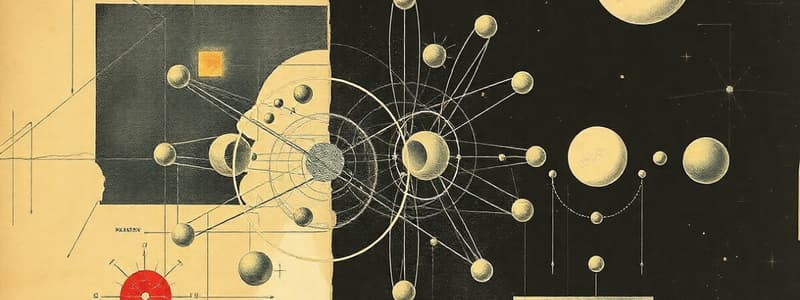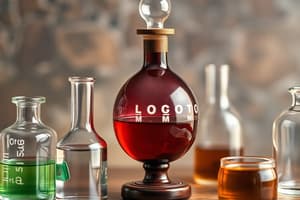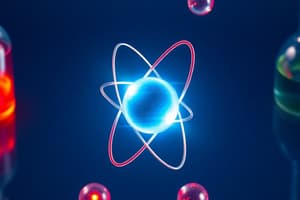Podcast
Questions and Answers
Who proposed the idea that matter is composed of indivisible particles called atomos?
Who proposed the idea that matter is composed of indivisible particles called atomos?
- James Chadwick
- John Dalton
- Ernest Rutherford
- Democritus (correct)
Which philosopher developed the theory of paramanu, suggesting all matter is made up of these small particles?
Which philosopher developed the theory of paramanu, suggesting all matter is made up of these small particles?
- J.J. Thomson
- Kanada (correct)
- Dmitri Mendelev
- Niels Bohr
What major discovery did J.J. Thomson contribute to atomic theory?
What major discovery did J.J. Thomson contribute to atomic theory?
- The neutron
- The nucleus
- The proton
- The electron (correct)
Which model of the atom was proposed by Ernest Rutherford following his gold foil experiment?
Which model of the atom was proposed by Ernest Rutherford following his gold foil experiment?
What did Niels Bohr contribute to the atomic model in 1913?
What did Niels Bohr contribute to the atomic model in 1913?
Who discovered the neutron, completing the modern atomic model?
Who discovered the neutron, completing the modern atomic model?
What does the periodic table organize elements by?
What does the periodic table organize elements by?
Who is credited with designing the periodic table?
Who is credited with designing the periodic table?
What makes noble gases unreactive?
What makes noble gases unreactive?
How many electrons does hydrogen need in its outer shell to achieve stability?
How many electrons does hydrogen need in its outer shell to achieve stability?
What type of bond is formed between two hydrogen atoms?
What type of bond is formed between two hydrogen atoms?
How many electrons does each fluorine atom share in a covalent bond?
How many electrons does each fluorine atom share in a covalent bond?
What is the total number of electrons in the outer shell of neon?
What is the total number of electrons in the outer shell of neon?
In a hydrogen fluoride molecule, how many electrons does fluorine have in its outer shell?
In a hydrogen fluoride molecule, how many electrons does fluorine have in its outer shell?
Which statement about the stability of noble gases is true?
Which statement about the stability of noble gases is true?
Which atom is reactive due to needing one more electron to fill its outer shell?
Which atom is reactive due to needing one more electron to fill its outer shell?
What does the atomic number of an element represent?
What does the atomic number of an element represent?
How are elements organized in periods of the periodic table?
How are elements organized in periods of the periodic table?
What are metalloids characterized by?
What are metalloids characterized by?
Which group of elements is known for being chemically inert?
Which group of elements is known for being chemically inert?
What happens to sodium when it loses an electron?
What happens to sodium when it loses an electron?
What is the most likely outcome of chlorine gaining an electron?
What is the most likely outcome of chlorine gaining an electron?
What is ionic bonding primarily characterized by?
What is ionic bonding primarily characterized by?
What type of bonds are formed in metallic bonding?
What type of bonds are formed in metallic bonding?
How many periods are there in the periodic table?
How many periods are there in the periodic table?
What characteristic do alkali metals share?
What characteristic do alkali metals share?
What defines a covalent bond?
What defines a covalent bond?
What elements are found in the f-block of the periodic table?
What elements are found in the f-block of the periodic table?
What does a metal's ability to conduct electricity primarily depend on?
What does a metal's ability to conduct electricity primarily depend on?
Flashcards
Democritus' Atomic Theory
Democritus' Atomic Theory
The idea that matter is made of small, indivisible particles called atoms.
Kanada's Atomic Theory
Kanada's Atomic Theory
He proposed that all matter is made up of paramanu (small, indivisible particles) which combine to form larger substances. His theory is remarkably similar to modern atomic theory.
Dalton's Atomic Theory
Dalton's Atomic Theory
Dalton revived the atomic theory, stating that all matter is made of indivisible atoms. Each element has its own type of atom, and these atoms combine in fixed ratios to form compounds.
Thomson's Atomic Model
Thomson's Atomic Model
Signup and view all the flashcards
Rutherford's Atomic Model
Rutherford's Atomic Model
Signup and view all the flashcards
Bohr's Atomic Model
Bohr's Atomic Model
Signup and view all the flashcards
Chadwick's Discovery
Chadwick's Discovery
Signup and view all the flashcards
What is the Periodic Table?
What is the Periodic Table?
Signup and view all the flashcards
Why are Noble Gases Unreactive?
Why are Noble Gases Unreactive?
Signup and view all the flashcards
How do Hydrogen and Carbon Bond?
How do Hydrogen and Carbon Bond?
Signup and view all the flashcards
Why is a Single Hydrogen Atom Reactive?
Why is a Single Hydrogen Atom Reactive?
Signup and view all the flashcards
Why is a Single Carbon Atom Reactive?
Why is a Single Carbon Atom Reactive?
Signup and view all the flashcards
Why is a Single Fluorine Atom Reactive?
Why is a Single Fluorine Atom Reactive?
Signup and view all the flashcards
Why is a Single Neon Atom Unreactive?
Why is a Single Neon Atom Unreactive?
Signup and view all the flashcards
How many electrons does hydrogen need to be stable?
How many electrons does hydrogen need to be stable?
Signup and view all the flashcards
How are hydrogen atoms bonded together?
How are hydrogen atoms bonded together?
Signup and view all the flashcards
Atomic Number
Atomic Number
Signup and view all the flashcards
Periods
Periods
Signup and view all the flashcards
Groups (families)
Groups (families)
Signup and view all the flashcards
Metals
Metals
Signup and view all the flashcards
Non-metals
Non-metals
Signup and view all the flashcards
Metalloids
Metalloids
Signup and view all the flashcards
S-block Elements
S-block Elements
Signup and view all the flashcards
P-block Elements
P-block Elements
Signup and view all the flashcards
D-block Elements (Transition Metals)
D-block Elements (Transition Metals)
Signup and view all the flashcards
F-block Elements
F-block Elements
Signup and view all the flashcards
Noble Gases
Noble Gases
Signup and view all the flashcards
Electron Shells and Reactivity
Electron Shells and Reactivity
Signup and view all the flashcards
Alkali Metals (Group 1)
Alkali Metals (Group 1)
Signup and view all the flashcards
Covalent Bonding
Covalent Bonding
Signup and view all the flashcards
Metallic Bonding
Metallic Bonding
Signup and view all the flashcards
Study Notes
Atomic Structure and Bonding
- Early Atomic Theories:
- Democritus (400 BCE) proposed the concept of indivisible atoms (atomos).
- Kanada (600 BCE) developed a similar theory in ancient India, proposing indivisible particles (paramanu).
- John Dalton (1803) revived atomic theory, stating matter is composed of atoms of specific elements that combine in fixed ratios.
Evolution of the Atomic Model
- J.J. Thomson (1897): Discovered the electron, leading to the "plum pudding" model.
- Ernest Rutherford (1911): Conducted the gold foil experiment, discovering the atomic nucleus and proposing the nuclear model.
- Niels Bohr (1913): Refined Rutherford's model, proposing electrons orbit the nucleus in fixed energy levels.
- James Chadwick (1932): Discovered the neutron, a neutrally charged particle, completing the atomic model.
Modern Atomic Theory
- The quantum mechanical model describes electrons as probability clouds, not fixed orbits.
The Periodic Table
- Definition: A chart organizing chemical elements based on atomic number, electron configuration, and recurring properties.
- Dmitri Mendeleev: Designed the periodic table.
- Atomic Number: The number of protons in an element's nucleus.
- Periods: Horizontal rows in the table; atomic number increases from left to right.
- Groups/Families: Vertical columns; elements within a group share similar chemical properties due to similar valence electron configurations.
- Groups 1 and 2: S-block
- Groups 13-18:P-block
- Groups 3-12:D-block
- Lanthanides and Actinides:F-block
- Noble Gases: Group 18; unreactive due to full outer electron shells.
- Includes helium, neon, argon
Categories of Elements
- Metals: Shiny, good conductors, malleable, ductile.
- Nonmetals: Brittle, poor conductors, low melting points.
- Metalloids: Have properties between metals and nonmetals.
Electron Shells and Reactivity
- Electron Shells: Layers surrounding the nucleus where electrons reside (K, L, M, etc.).
- Valence Electrons: Electrons in the outermost shell; determine chemical reactivity. Atoms strive toward full valence shells. -Atoms become stable when their valence shell is filled.
- Reactivity Trends:
- Noble Gases: Full valence shells, inert.
- Alkali Metals: One valence electron, highly reactive (lose electron to attain full shell)
- Halogens: Seven valence electrons, highly reactive (gain electron to attain full shell).
Ionic Bonding
- Formation of Sodium Chloride (NaCl):
- Sodium (Na) loses one electron, becoming Na⁺.
- Chlorine (Cl) gains one electron, becoming Cl⁻.
- Oppositely charged ions attract, forming an ionic bond.
Covalent Bonding
- Electron Sharing: Atoms share electrons to achieve filled valence shells.
- Hydrogen Molecule (H₂): Two hydrogen atoms share one electron each.
- Examples: Water (H₂O), many organic compounds.
Metallic Bonding
- Electron Sea: Valence electrons move freely throughout the metal structure.
- Properties: Conductivity (heat and electricity), malleability, ductility.
Hydrogen and Carbon Bonding
- Covalent bonds: Electrons shared between hydrogen and carbon atoms.
Studying That Suits You
Use AI to generate personalized quizzes and flashcards to suit your learning preferences.



